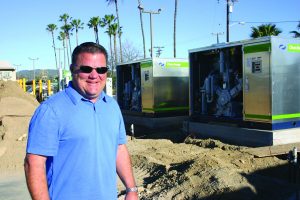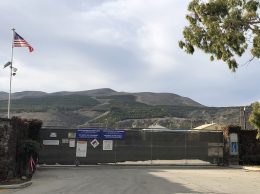Tri-county trash companies investing in alternative fuels
IN THIS ARTICLE
- middle Topic
- Philip Joens Author
By Philip Joens Friday, April 22nd, 2016

Mike Harrison of Harrison Industries poses with compressed natural gas fueling stations.
A Ventura waste collection company is investing again in alternative fuels.
Harrison Industries began installing 13 new compressed natural gas fueling stations for trucks at its Saticoy work yard in late February.
All three trash companies that serve the Tri-Counties began using alternative fuel trucks several years ago and alternative fuel stations are popping up for cars in Ventura and Santa Barbara counties.
Liquefied natural gas and compressed natural gas are appealing fuels for short haul industrial vehicle fleets because they burn cleaner than diesel fuel and also cost less than diesel. Large companies like Waste Management and the United Parcel Service use vehicles that run on CNG. Several regional bus fleets also run on CNG.
Harrison Industries began using alternative fuels in 2002 when it retrofitted several trucks to run on LNG. Liquefied natural gas is natural gas cooled to minus 260 degrees Fahrenheit and turned into a liquid. When a truck’s engine is started, LNG is heated and turned back into a gas. Compressed natural gas, meanwhile, is simply natural gas compressed and stored at very high pressures.
LNG requires a smaller gas tank than CNG, but Mike Harrison, Harrison Industries engineering manager, said CNG outperforms LNG.
“Back in the early 2000s, LNG was better,” Harrison said. “They’ve had CNG engines for a while but, in the early 2000s, they had to perfect the engines.”
The fuels are also cheaper than diesel. In January, West Coast CNG prices averaged $2.71 per diesel gallon equivalent, according to the U.S. Department of Energy, compared to $2.55 per gallon of diesel. Harrison said LNG is typically more expensive than CNG, but still cheaper than diesel.
Harrison Industries currently has 33 LNG trucks and 13 CNG trucks. Work began in late February to install 13 new CNG fueling stations with two pumps each. Harrison said the company will probably not expand its LNG program because CNG costs less and performs better.
The project requires Harrison Industries to install electrical lines to give the new stations power air compressors. Filling is easy, but takes time. Employees park the CNG trucks at a station each night, insert each gas pump and let it refuel overnight.
The trucks don’t come cheap, though.
“They’re expensive,” said Pat Fenton, district manager for Waste Connections in San Luis Obispo. “They’re almost $400,000.”
Waste Connections, which serves San Luis Obispo County, has 25 CNG trucks in a fleet of 86 garbage trucks. Harrison said they cost closer to $350,000, but that new diesel trucks cost around the same. Both men said retrofit options exist for diesel trucks, but cost too much to make it economically feasible.
Despite the cost, Fenton said, Waste Connections wants to replace aging diesel trucks with CNG trucks.
“We have 25 of them and we’re going to try to get more,” Fenton said.
Mechanics tend to dislike CNG trucks because many mechanics have done things the same way for a long time and the trucks require special training to maintain. They can also handle differently than diesel powered trucks.
“They’re harder to maneuver sometimes because the (gas) tanks are on top of the trucks,” Fenton said.
MarBorg industries in Santa Barbara has used CNG trucks for about a decade. On its website, MarBorg said the trucks reduce emissions by 23 percent compared to diesel trucks.
Harrison said CNG burns cleaner than diesel fuel and gasoline, but it is still a non-renewable fuel. Small cars and trucks can also run on CNG. Eight CNG fueling stations exist in the region in Santa Barbara and Ventura counties, according to the U.S. Department of Energy.
A fueling station for hydrogen, another alternative fuel, began operation in Santa Barbara last month. Conserv Fuel opened the gas pump at its Santa Barbara location at 150 S La Cumbre Road.
The fueling station for hydrogen-powered cars is one of just 24 in the country, according to the U.S. Department of Energy, and the first in the Tri-Counties.
• Contact Philip Joens at pjoens@pacbiztimes.com.
Related Articles
 Friday, October 14th, 2022
Friday, October 14th, 2022










